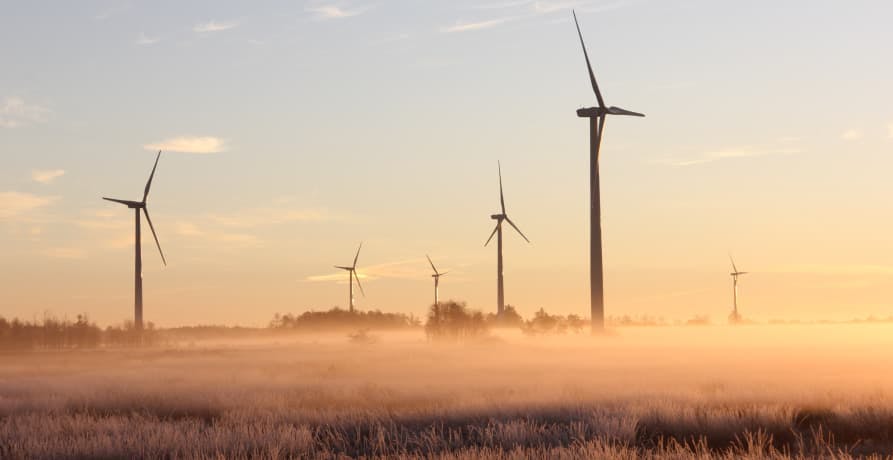ESG / CSR
Industries
How Nordic countries are facing climate change together



The Nordic countries are seen as some of the most progressive societies in the world, and when it comes to climate action they’re no different. Few regions showcase the intersection of progressive social and welfare policies with environmental policies quite like the Nordic countries.
The Nordics demonstrate how reducing emissions goes hand in hand with enhancing the health and lives of citizens. Their advanced energy transitions, innovative decarbonization strategies, and ambitious climate policies are not just helping to cut global greenhouse gas emissions but are also boosting economic growth and societal well-being. In this article we’ll explore how the Nordic countries are collaboratively tackling climate change, aligning their social models with a sustainable future, and offering lessons on how environmental responsibility and economic progress complement each other.
In this article, we examine how the Nordic countries are combining progressive social policies with strong environmental actions to address the challenges of climate change.
The Nordic approach to climate change
When it comes to addressing the global climate crisis, the Nordic countries - Denmark, Finland, Iceland, Norway, and Sweden - are seen as world leaders. Through the implementation of innovative decarbonization strategies and progressive public policies, they boast the most advanced energy transitions in Europe and are demonstrating that it's possible to align environmental stewardship with economic growth.
Due to the region's northern latitude and a phenomenon known as polar amplification, these countries are witnessing the impacts of climate change firsthand - some areas have recorded a shocking increase of 10 degrees Celsius compared to the start of the preindustrial era! This increase vastly supersedes the Paris Agreement target of limiting global warming to 2 °C. This is why the region has developed some of the most advanced carbon-cutting strategies.
In the past twenty years, the Nordics have made more progress than most European Union member states and at a quicker pace. The Nordic approach to climate change proves that it’s possible to decouple greenhouse gas (GHG) emissions from economic growth. The carbon intensity of Nordic electricity is under 60 gCO2/kWh, compared to a global average of over 500 - this means that the CO2 emissions per unit of electricity produced in the Nordics are only 8% of the global average. Yet at the same time, the total GDP of these countries collectively grew by between 2.5 and 3.5% over the same period.
Through a mix of ambitious environmental goals, innovative technology, and inclusive policies that ensure society as a whole progresses towards sustainability, the Nordic countries are setting an example, proving that environmental responsibility and economic advancement can co-exist. In this article, we’ll explore the specifics of their renewable energy achievements, emission targets, and innovative sustainable living practices, highlighting how the Nordics are not just creating a sustainable future for the region, but also providing a template for the rest of the world.


Pioneering renewable energy and efficiency
Given the cold northern location of the Nordic countries, traditionally their energy consumption and GHG emission rates per capita have been high. Long, dark, cold winters combined with remote areas necessitating significant travel distances mean that energy efficiency has been a hot topic in the region for some time now. Yet, the Nordic countries have been able to cut annual CO2 emissions from household heating systems to 0.2 tonnes of CO2 per capita - significantly lower than the average 0.8 tonnes for OECD European countries.
How have the Nordic countries managed to achieve this? Nordic countries have long been at the forefront of championing renewable energy sources - a key element in their strategy to combat climate change. This region's commitment to sustainability is evident in its diverse mix of renewable energy, which includes hydropower, wind power, geothermal energy, and biomass. The energy mix of the region means that around 36 to 73% of energy consumption comes from renewable sources. This can be compared to the EU’s share of just 18 to 28%.
Norway’s electricity for example is almost entirely sourced from renewables, primarily hydropower, accounting for 92% of the country’s electricity. Sweden is also heavily reliant on hydropower, with 41% of its electricity stemming from this source (a further 29% comes from nuclear power). Iceland is another Nordic country whose electricity generation is largely dependent on hydropower, with 70% of the country’s electricity generation sourced this way, geothermal energy further adds to the country’s clean energy mix. Denmark, on the other hand, has become a global leader in wind power, with a substantial portion of its electricity generated from wind turbines 80% of the country’s energy stems from wind, bioenergy, and solar photovoltaic.
Apart from diversifying their energy sources, the Nordic countries have also focused on energy efficiency - an often overlooked but important aspect of reducing GHG emissions. Innovations in low-energy construction, district heating systems, and energy-efficient industrial processes have reduced their carbon footprint. For example, advancements in household heating systems have significantly lowered carbon dioxide emissions per capita in the region.
The Nordic countries' holistic approach to energy use, where both the source and the efficiency of consumption are equally prioritized has been incredibly successful, as evidenced by the fact that the region's CO2 emissions per unit of electricity are markedly lower than the global average. As the Nordics continue to innovate and improve in these areas, they provide valuable lessons and models for other countries aiming to transition to a sustainable energy future.
Ambitious emissions reduction targets
The Nordic countries have set themselves apart when it comes to their ambitious emission reduction targets. Each country has outlined bold targets for the upcoming decades, showcasing its commitment to a sustainable and low-carbon future.
In line with EU targets, the Nordic countries have set a target of reducing emissions by 40% by 2030 (compared to 1990 levels). However, many of the countries in the region have set even more ambitious emissions reduction goals. Take Denmark, for example, the country has set the aim of sourcing its entire energy mix from renewable sources by 2030, a move that is predicted to result in a 75% reduction in greenhouse gas emissions. Similarly, Norway aims to reach carbon neutrality by 2030, Finland aims to achieve this by 2035, and Sweden has set the target of reaching net zero emissions by 2045.
Norway's commitment to become carbon-neutral by 2030 is particularly noteworthy as this will involve balancing out any unavoidable GHG emissions produced with equivalent carbon offsets, such as investing in renewable energy projects abroad.
What’s more, is that these targets are not just aspirational, they’re backed by concrete policies and actions. National policies help to incentivize the use of green energy, even when they might not be the cheapest option. Energy and carbon taxes for example have helped to incentivise the switch to renewable energy sources, and taxes on energy and fossil fuels are generally higher in the region when compared to elsewhere in Europe. The results of these policies speak for themselves; generally, there has been widespread public support for the initiatives and the use of biofuels, heat pumps, and other green alternatives is increasing.


Innovations in sustainable living
The Nordic countries are well-known for integrating sustainability into everyday life. These innovations range from architectural designs to energy solutions and are helping to significantly reduce the environmental footprint of their societies.
One such area of innovation is in the building and construction sector. The Nordic region is known for its cold, long winters - this means that keeping houses warm is paramount, something that places pressure on the region’s energy sector. One way that Nordic countries are countering this is through low-energy building design, helping to reduce the energy demand for new buildings. For example, thanks to increasingly strict energy efficiency standards Denmark has seen an 80% drop in the energy requirement of its new buildings since the 1970s. This achievement is the result of stringent energy efficiency standards that promote thermal insulation, air-tightness, the optimization of windows’ heat loss/gain, and improved energy efficiency of heating, lighting, and ventilation.
Another area where the Nordics excel is in their heating systems. Innovations in district heating, particularly in Denmark and Sweden, have led to substantial reductions in carbon dioxide emissions. By making use of surplus heat from industrial processes and integrating bioenergy, these district heating systems are a testament to the efficient use of available resources. In fact, district heating schemes now provide over half of Sweden’s heating needs. Large-scale district heating systems are not only more efficient, they also are less polluting than boilers in individual dwellings. What’s also notable is that as the world continues to heat and summers within the Nordic region get warmer, district heating systems are also increasingly being used for district cooling purposes.
Transportation is another sector where the Nordic countries are making significant strides. Policies aimed at increasing the use of renewable energy and promoting low-emission vehicles are in place across the region. Efforts to boost the market share of biofuels, the promotion of electric vehicles, and the development of efficient public transportation systems are all part of their comprehensive approach to reducing emissions from the transport sector. And the measures seem to be working, in Norway for example, electric vehicles (EVs) accounted for 82% of new vehicles sold in 2023, up from 79% in 2022. This places the country at the top of the league for the country with the highest share of zero-emission vehicles in its passenger car fleet.
These examples of sustainable living practices in the Nordic region highlight a key takeaway: tackling climate change is not just about government policies or international agreements, it's also about changing the way we live our daily lives. The Nordics are leading by example, showing that sustainable living is not only possible but also beneficial for the environment, the economy, and our quality of life.
Economic and social aspects of climate policy
The Nordic model refers to the combination of social welfare and economic systems that exist within the Nordic countries. It’s a combination of capitalist mechanisms such as a market economy and the prioritization of economic efficiency, combined with robust social benefits such as state pensions and income distribution. It is this mix that makes the region one of the most progressive and equitable societies in the world. This model is also the reason why the region has been able to implement climate change policies so effectively.
The Nordic countries' approach to climate change is deeply linked with economic and social considerations. Instead of viewing environmental policies as a hindrance to economic growth, these nations demonstrate that sustainable practices can actually foster economic development and social welfare.
A key aspect of the Nordic model is the recognition that green technologies are not just environmental tools but also help create jobs and diversify the economy. For example, Denmark’s leadership in wind energy has not only reduced its carbon footprint but also strengthened its economy, creating thousands of jobs and boosting exports in the green technology sector. The wind power sector now accounts for more than 4% of Danish exports. The government was able to support this growth within the sector by backing research and innovation and championing feed-in tariffs to guarantee ROI for developers. Likewise, Sweden’s investment in bioenergy and district heating systems has also spurred growth in related industries.
Social acceptability is another crucial aspect of the Nordic strategy. These countries understand that for environmental policies to be successful, they must have broad public support. This is achieved through a combination of public awareness campaigns, education, and ensuring that policies are fair. For example, while the Nordic countries impose higher taxes on energy and fossil fuels, they also provide social welfare policies that enable all segments of the population to meet their energy needs sustainably. This approach helps ensure that the transition to a greener economy is inclusive and enjoys widespread public support.
Joint Nordic action on climate change
In the fight against climate change, the Nordic countries have distinguished themselves not only through individual efforts but also through their joint initiatives. These collaborative actions, coordinated through various regional organizations and partnerships, support their commitment to shared environmental goals and global sustainability. From pooling resources to spearheading innovative projects, the Nordic nations demonstrate the power of cooperation in addressing the challenges of climate change. Below, we explore the key organizations and initiatives that are helping the Nordic region to decarbonize their societies.
The Nordic Council of Ministers (NCM): a platform for regional cooperation
The NCM is the official inter-governmental body overseeing cooperation within the Nordic region. It plays a crucial role in aligning the Nordic countries' climate strategies and policies and facilitates the development of regional projects aimed at enhancing environmental sustainability and combating climate change. Examples of initiatives include developing models and tools for reforming the subsidy system to fossil fuels (FFSR) and research into how green technology can be rolled out.
Nordic Environment Finance Corporation (NEFCO): financing green initiatives
NEFCO focuses on funding environmentally beneficial projects, both within the Nordic region and internationally. It specializes in supporting small and medium-sized projects that demonstrate innovative approaches to environmental challenges.
NEFCO works closely with both private and public investors and beneficiaries. This approach means that NEFCO can help borrowers identify, develop, and implement green projects, making them more attractive to other investors in the process. NEFCO’s funding has contributed to local capacity building and the transfer of knowledge and technology.
Nordic Climate Facility (NCF): innovative climate change projects
Financed by the Nordic Development Fund (NDF), the NCF funds projects that tackle climate change through innovative methods. These initiatives are implemented through collaborations between Nordic organizations and local partners in eligible countries.
Nordic Investment Bank (NIB): supporting sustainable development
The NIB plays a key role in financing projects that promote environmental sustainability in the Nordic and Baltic regions. It backs projects that boost the use of renewable energy and enhance energy efficiency, contributing to the region’s sustainable development through the provision of long-term loans to private and public sector partners in the Nordic and Baltic regions.
Many of the NIB-backed projects focus on increasing the use of renewable energy and improving energy-efficient infrastructure and public transport schemes.
Nordic support for global climate action
Beyond their borders, the Nordic countries are also committed to supporting sustainable development worldwide. This includes providing financial aid, technical expertise, and policy development support to low-income countries to foster sustainable practices. Through these initiatives, the Nordic countries demonstrate that collaborative action can amplify the impact of efforts to combat climate change, setting an example for international cooperation and partnership.
What about Greenly?
At Greenly we can help you to assess your company’s carbon footprint, and then give you the tools you need to cut down on emissions. Why not request a free demo with one of our experts - no obligation or commitment required.
If reading this article has inspired you to consider your company’s own carbon footprint, Greenly can help. Learn more about Greenly’s carbon management platform here.



